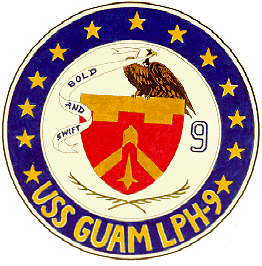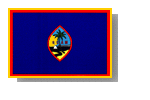|
Battle of Guam |
|
| Decom Info Page USS
GUAM USS GUAM PW 3 Commanding Officer's Plank Owners
|
On December 7, 1941, when the Japanese struck in the Pacific the total strength of the Marine Barracks, Naval Station, Guam, consisted of seven officers, one warrant officer and 147 enlisted men under the command of Lt. Col. William K. MacNulty. Chief Radioman George R. Tweed, USN, who spent more than 2 1/2 years eluding the Japanese on Guam, related the story of the U.S. Marine garrison’s valiant defense: "At about 9 a.m., December 8, 1941 (Dec. 7, U.S. time), the first Jap planes came over. They came continuously for two days, bombing and strafing. At sunset of the second day, (December 9) Japanese transports showed up, they began landing about midnight. We had so few guns, so little ammunition, there wasn’t much we could do. We had only about 200 Marines, a few scattered naval personnel and the island defense company. The Marines on Cabras Island, a narrow strip of land off the harbor, armed only with machine guns, actually repulsed the Japs until their ammunition gave out. A couple of one-pound guns on ships in the harbor fired to the last while a single machine gun on Agana Heights, above the town, the only AA battery we had, exhausted its ammunition. The Japs forced a landing and rolled into the town shooting. The Marines fought them street by street, house by house. One squad of the Marines at the civilian jail had two tommy guns. They fought to the last." During the period Dec. 7 to 10, 1941 four enlisted Marines were killed or died of wounds. The remainder of the personnel (151 officers and enlisted men) were captured. The Japs later claimed that in addition to Capt. G.J. MacMillan, USN, the Governor of Guam and 440 other officers and men were captured by the Japanese forces when the island was occupied Dec. 10. On July 20, 1944 (U.S. time), approximately 2 1/2 years after the Japanese conquest of the island, the Marines came back to Guam to avenge the small garrison, which lost to the vastly superior force. The Third Marine Amphibious Corps arrived ashore on each side of Port Apra while the First Provisional Marine Brigade landed between Point Banji and Agat. Elements of the Army’s 77th Infantry Division landed later. The Marine forces quickly established perimeters and fanned out into the interior of the 225-square mile island, fighting on American soil for the first time since beginning their victorious push across the Central Pacific exactly eight months previous. With the exception of three remote islands in the Aleutions off Alaska, Guam was the first piece of American terrritory to be recaptured from Japan. The Guam landings came after a 17-day aerial and naval bombardment which established a record tonnage. On the day preceding the landings, carrier planes also established a Pacific record by dropping 627 tons of bombs and 147 individual rockets. The day of the landing, the warships (including new battleships with the heaviest firepower of any of the world’s ships) threw 1,100 tons of shells on Guam’s defenses. Mr. John R. Henry, representing the combined Allied press, characterized the Guam undertaking as "the smoothest amphibious operation of the Pacific War." Twenty-one days after the return of U.S. forces on the island of Guam and after further fighting with the Japanese still remaining on the island, organized resistance on Guam ended August 9. The capture of Guam and its neighbors, Saipan and Tinian, provided the Allies with bases from which to launch the devastating B-29 raids which were climaxed by the use of the atomic bomb on Hiroshima and Nagasaki. In addition to its obvious military value, the island’s recapture provided a strong morale boost to the American people. During the Guam campaign, U.S. casualties totaled 1,214 killed, 5,704 wounded and 329 missing.
|

